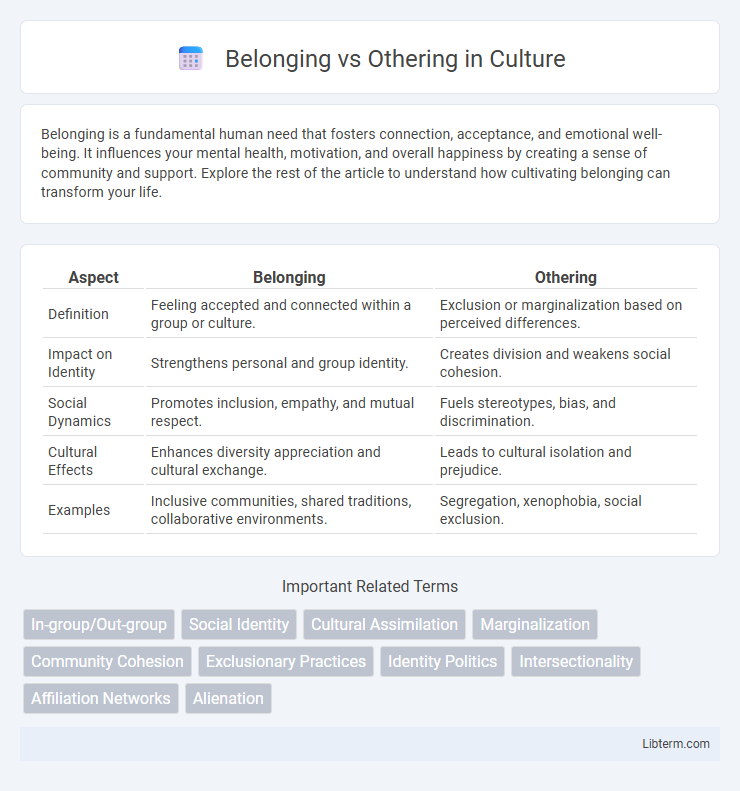Belonging is a fundamental human need that fosters connection, acceptance, and emotional well-being. It influences your mental health, motivation, and overall happiness by creating a sense of community and support. Explore the rest of the article to understand how cultivating belonging can transform your life.
Table of Comparison
| Aspect | Belonging | Othering |
|---|---|---|
| Definition | Feeling accepted and connected within a group or culture. | Exclusion or marginalization based on perceived differences. |
| Impact on Identity | Strengthens personal and group identity. | Creates division and weakens social cohesion. |
| Social Dynamics | Promotes inclusion, empathy, and mutual respect. | Fuels stereotypes, bias, and discrimination. |
| Cultural Effects | Enhances diversity appreciation and cultural exchange. | Leads to cultural isolation and prejudice. |
| Examples | Inclusive communities, shared traditions, collaborative environments. | Segregation, xenophobia, social exclusion. |
Understanding Belonging: Definition and Importance
Understanding belonging involves recognizing the emotional experience of being accepted, valued, and connected within a group or community. Belonging plays a critical role in mental health, influencing self-esteem, motivation, and overall well-being by fostering a sense of security and identity. Its importance is evident in diverse contexts such as workplaces, schools, and social settings, where belonging enhances collaboration, productivity, and social cohesion.
The Psychology of Othering: How It Manifests
The psychology of othering manifests through cognitive biases that categorize individuals into in-groups and out-groups, fostering exclusion and prejudice. Neurological studies reveal heightened amygdala activation when encountering those perceived as "others," triggering fear and distrust responses. Social identity theory explains how this process solidifies group cohesion but simultaneously intensifies social divisions, perpetuating systemic discrimination.
Historical Perspectives on Belonging and Exclusion
Historical perspectives on belonging and exclusion reveal how societies have constructed identities through processes of inclusion and othering, often tied to race, ethnicity, religion, and class. Examples include colonialism imposing hierarchical racial categories, apartheid institutionalizing segregation, and citizenship laws defining who belongs within nation-states. These patterns of exclusion shaped social hierarchies, resource distribution, and cultural narratives, reinforcing power dynamics and systemic inequalities over centuries.
The Role of Identity in Belonging vs Othering
Identity shapes individual and group belonging by defining shared values, cultural norms, and social affiliations that foster inclusion within communities. When identities are marginalized or contrasted with dominant groups, othering occurs, creating exclusion and reinforcing social hierarchies. Understanding the dynamic interplay between identity and social boundaries is crucial for addressing discrimination and promoting cohesive societies.
Social Impacts of Belonging on Communities
Belonging fosters social cohesion by enhancing trust, cooperation, and collective identity within communities, which reduces social isolation and conflict. Strong senses of belonging improve mental health outcomes and increase community resilience against social and economic challenges. Inclusive environments promote equity and encourage active participation, driving sustainable community development.
Consequences of Othering: From Marginalization to Division
Othering leads to social marginalization by excluding individuals or groups from mainstream opportunities, fostering environments where discrimination and inequality thrive. This exclusion intensifies division within communities, eroding social cohesion and increasing tensions across cultural, ethnic, or ideological lines. Such polarization undermines collective progress and can escalate conflicts, making the reconciliation of diverse societies increasingly challenging.
Belonging in the Workplace: Strategies for Inclusion
Creating a culture of belonging in the workplace enhances employee engagement, productivity, and retention by fostering inclusive practices that validate diverse perspectives. Implementing strategies such as equitable communication, collaborative decision-making, and cultural competency training supports an environment where individuals feel valued and integral to the organization's success. Data shows that companies prioritizing belonging experience up to 70% higher employee innovation and 50% reduction in turnover rates.
Overcoming Othering: Tools for Building Unity
Overcoming othering requires intentional strategies such as empathy-building exercises, inclusive language, and community engagement initiatives that promote understanding across diverse groups. Programs fostering intergroup dialogue and collaborative projects can break down stereotypes and reduce prejudice, encouraging a sense of shared identity. Leveraging digital platforms for inclusive storytelling and amplifying marginalized voices also plays a crucial role in building unity and reinforcing belonging.
Media Influence on Belonging and Othering Narratives
Media plays a crucial role in shaping narratives of belonging and othering by framing social groups through selective representation and language use. News outlets, films, and social platforms amplify inclusion or exclusion by highlighting stereotypes or showcasing diverse identities, influencing public perception and social cohesion. Patterns of media bias and repetitive portrayals contribute to reinforcing societal divisions or promoting empathy and acceptance within communities.
Fostering a Culture of Belonging: Practical Steps Forward
Creating an inclusive workplace requires intentional efforts to foster a culture of belonging by promoting open communication, empathy, and diverse representation. Developing policies that encourage collaboration and recognize individual contributions helps mitigate feelings of othering. Consistent training on unconscious bias and active engagement initiatives further strengthen community ties and support sustained inclusivity.
Belonging Infographic

 libterm.com
libterm.com